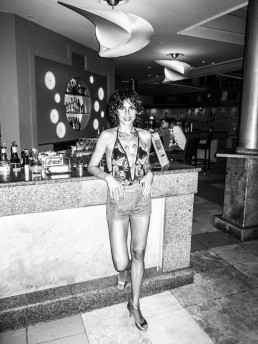The product designer Hans Karuga lives and works in Weßling/Munich. Besides his passion for tables, he is mot interested in lighting design. His products are characterized by a clear formal language, technical sophistication and multifunctional light solutions for special situations. In the interview with serien.lighting he talks about his design philosophy, dream projects and the future of lighting design. Learn more about his work on his homepage or jumpt directly to TWIN.
You were first trained as a dental technician. How did you get from there to product design?
HK: I got in touch with it when I heard about the department of product design at the University of Munich and I immediately knew that this is exactly what I want to do. However, I missed the application deadline. I still wanted to do something handcrafted, so I started the training as a dental technician. A great craft, but very narrowly focused on teeth, you get to know nothing about the world around you.
Do you think the mechanical and technical aspect of dental technology helped you later as a product designer?
HK : I see the dental technology rather as a loop way to product design. However, it covered me financially during my design studies, int the evenings I worked in the laboratory.
Can you remember your first luminary design?
HK : Yes, that was for my sister’s the doll house. I designed a luminaire made of paper that actually worked with the help of a model railway bulb. I also fitted the doll house with stairs and furniture. Only later I realized that I already as a child I enjoyed what is my profession today. When I started to study the doll house occurred to me again.
What excites you most about luminaries and what is the difference to furniture design?
HK: I came to lighting design rather by chance through my thesis. I designed a special dental microscope because I was always dissatisfied with the one I used as a dental technician. Through the company that developed my design, I got into the office lighting. Of course, the quality of the light is thereby the main factor. I find that most people are very insensitive in dealing with the effects of light and are barely capable of judging good light.
Did you already when designing a concrete light situation in your head?
HK: The requirement for the light in a particular situation is very important. Then there are also the technical requirements of the bulb, in the past halogen or fluorescent, today especially LED. Of course, the luminary also has to be mechanically well-structured – all these factors influence each other and ultimately influence the formal shape.
In what ways do new technologies affect lighting design?
HK: Already today manufacturers barely dare to present new halogen luminaries, although it is a great light source. LED is very interesting, in a way it revolutionized the approach in lighting design. Nevertheless, facts remain that you can’t ignore: namely, that in a LED huge luminance is compressed to a tiny point that needs to be tempered by a fluorescent screen or dimming. Here, we are again close to typical lighting configurations of the past. If you want to experiment and try something new, you always have to deal with a certain uncertainty because you don’t know how LED technology will continue to develop. Both customers, but also manufacturers often know too little about features of different light sources such as lumens, color temperature or color rendering (Ra) .
What was your idea or inspiration for Twin?
HK: The starting point was a X-scissors as an expressive connection of two reflectors. I wanted to design a luminary for large tables. The X- linkage should first not be adjustable. The cables should be run through the frame to the canopy. I built a small model where the X formed by two sticks was connected to a needle. This improvised connection of course didn’t hold tightly together and moved. So I came up with the adjustable twin principle.
What projects are you working on currently?
HK: I’m working on the new lighting of a Tai Chi space. It is a big, quite low, long and narrow space. Currently, a less efficient and glaring spot lighting is installed. I will only use LEDs and light the room rather indirectly. Also, I ‘m currently developing a small, high-intensity, mobile battery luminaire for light-intensive work that is even suitable for visually impaired people. In addition to luminaries I am currently very interested in tables.
Do you have a dream project that you haven’t realized yet?
HK: There is not only one dream project, but several. Two lighting designs that I have in mind need some more attention. I’m not satisfied yet and work on them from time to time. There is also a table design that does not let go of me, I have been experimenting with it for years. Sometimes it’s good to get a bit of distance from your own design and the go back it it with a fresh perspective.
Thank you for the interview!
Interview by Ella Lu Wolf, January 39th, 2014








